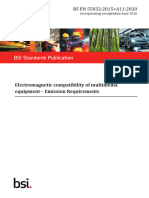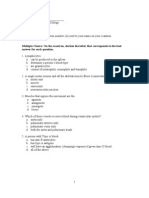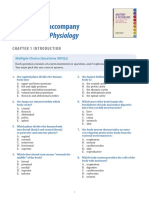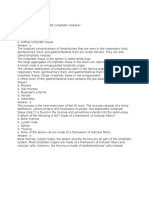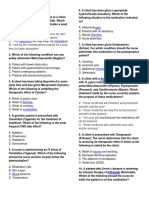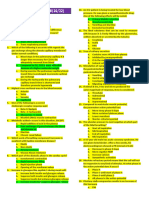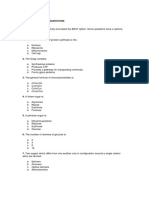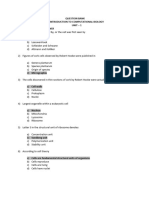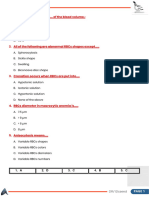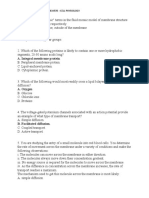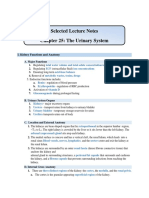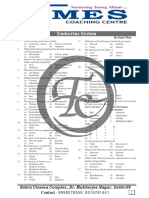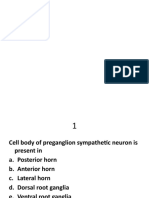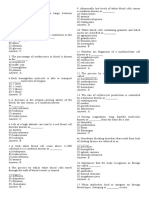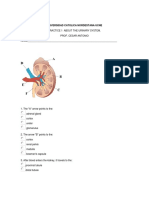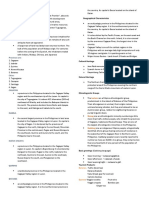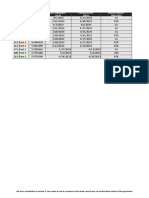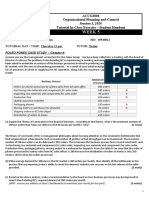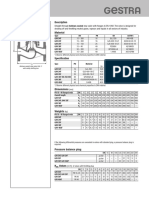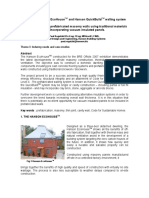CH 19
CH 19
Uploaded by
Blythe WilliamsCopyright:
Available Formats
CH 19
CH 19
Uploaded by
Blythe WilliamsOriginal Title
Copyright
Available Formats
Share this document
Did you find this document useful?
Is this content inappropriate?
Copyright:
Available Formats
CH 19
CH 19
Uploaded by
Blythe WilliamsCopyright:
Available Formats
Exam Name___________________________________
MULTIPLE CHOICE. Choose the one alternative that best completes the statement or answers the question. 1) Which of the following is a function of the blood? A) defense against toxins and pathogens B) transport of gases C) transport of nutrients and wastes D) transport of body heat E) all of the above 2) Which of the following statements about blood is false? A) is more viscous than water B) contains buffers that control pH C) normal pH is 6.8 to 7.0 D) is about 55 percent plasma E) None of the above is falseall are true. 3) Formed elements make up about what percentage of blood? A) 45 percent B) 55 percent C) 20 percent 4) The combination of plasma and formed elements is called A) extracellular fluid. B) lymph. C) packed blood. D) serum. E) whole blood. 5) Whole blood for testing in a clinical laboratory is usually collected from A) a superficial vein. B) an arteriole. C) a superficial artery. D) the heart. E) a capillary. 6) When checking the efficiency of gas exchange, it may be necessary to draw a blood sample from A) the lungs. B) a vein. C) capillaries. D) the heart. E) an artery. 7) Each of the following is a characteristic of whole blood, except a A) temperature of approximately 38 degrees Celsius. B) viscosity about the same as water. C) built-in system for clotting. D) deep red color from hemoglobin. E) pH of 7.4. 1)
2)
3) D) 38 percent E) 60 percent 4)
5)
6)
7)
8) The total volume of blood in the body of a 76-kg man is approximately ________ liters. A) 5.3 B) 3.8 C) 6 to 8 D) 4.4 E) 10 9) A person who has a low blood volume is said to be A) hypervolemic. B) hypovolemic. C) normovolemic. D) isovolemic. E) antivolemic. 10) The chief differences between plasma and interstitial fluid involves the A) concentration of electrolytes. B) concentration of water. C) concentration of glucose. D) concentration of proteins. E) concentration of nitrogen wastes. 11) The most abundant proteins in blood plasma are A) globulins. B) albumins. C) transport proteins. D) fibrinogens. E) lipoproteins. 12) Plasma proteins essential in body defense are the A) albumins. B) metalloproteins. C) fibrinogens. D) lipoproteins. E) immunoglobulins. 13) A plasma protein essential for blood coagulation is A) immunoglobulin A. B) metalloprotein D. C) lipoprotein C. D) albumin alpha. E) fibrinogen. 14) The most abundant component of plasma is A) nutrients. B) ions. C) water. 15) All the circulating red blood cells originate in the A) thymus. B) heart. C) spleen. D) red bone marrow. E) lymph tissue.
8)
9)
10)
11)
12)
13)
14) D) gases. E) proteins. 15)
16) The process of lymphopoiesis goes on in all of the following organs, except A) the thymus. B) the kidney. C) the lymph nodes. D) the red bone marrow. E) the spleen. 17) Granulocytes form in A) yellow bone marrow. B) the intestines. C) red bone marrow. D) the thymus. E) the spleen. 18) Red blood cell production is regulated by the hormone A) erythropoietin. B) angiotensin. C) thymosin. D) renin. E) M-CSF. 19) Which of the following statements concerning red blood cells is false? A) Red cells are specialized for carrying oxygen. B) Red cells are biconcave discs. C) Red cells lack mitochondria. D) Red cells are about 18 m in diameter. E) Red cells can form stacks called rouleaux. 20) The average lifespan of a red blood cell is A) about 1 year. B) 1 month. C) 24 hours. D) 4 months. E) many years. 21) The function of red blood cells is to A) carry carbon dioxide from the cells to the lungs. B) carry oxygen from the lungs to the body's cells. C) defend the body against infectious organisms. D) carry nutrients from the digestive system to the body's cells. E) both A and B 22) More than 95 percent of the protein in a red blood cell is A) fibrinogen. B) albumin. C) hemoglobin. D) porphyrin. E) immunoglobulin.
16)
17)
18)
19)
20)
21)
22)
23) The function of hemoglobin is to A) carry oxygen. B) carry carbon dioxide. C) aid in the process of blood clotting. D) A, B, and C E) A and B only 24) ________ is a condition in which the oxygen-carrying capacity of the blood is reduced. A) Polycythemia B) Leukopenia C) Thrombocytopenia D) Leukemia E) Anemia 25) Pernicious anemia caused by a lack of intrinsic factor is specifically treated by A) oral doses of iron. B) injections of vitamin B12. C) injections of iron. D) oral doses of vitamin B12. E) blood transfusion. 26) A red blood cell that contains normal amounts of hemoglobin would be called A) macrocytic. B) normochromic. C) hyperchromic. D) normocytic. E) hypochromic. 27) The conversion of fibrinogen to fibrin is catalyzed by the enzyme A) plasmin. B) prothrombinase. C) factor VIII. D) thrombin. E) fibrinogen-converting enzyme. 28) Aged and damaged erythrocytes are broken down by the A) liver. B) bone marrow. C) spleen. D) digestive tract. E) A, B, and C 29) The waste product bilirubin is produced from A) abnormal proteins found in red blood cells. B) heme molecules lacking iron. C) globin chains of hemoglobin. D) iron found in hemoglobin molecules. E) heme molecules plus iron.
23)
24)
25)
26)
27)
28)
29)
30) Most of the iron that is removed from degraded hemoglobin is A) excreted by the kidneys. B) stored in yellow bone marrow. C) excreted by the intestines. D) recycled to the red bone marrow. E) excreted by the liver. 31) In adults, erythropoiesis exclusively takes place in A) the liver. B) lymphoid tissue. C) yellow bone marrow. D) red bone marrow. E) the spleen. 32) In adults, red bone marrow is located in the A) sternum and ribs. B) diaphysis of long bones. C) iliac crest, body of vertebrae. D) A, B, and C E) A and C only 33) The process of red blood cell production is called A) hemocytosis. B) hematopenia. C) erythropoiesis. D) erythropenia. E) erythrocytosis. 34) The developmental stage at which erythrocytes enter the circulation is as A) myeloid cells. B) reticulocytes. C) hemocytoblasts. D) proerythrocytes. E) band forms. 35) ________ are immature erythrocytes that are present in the circulation. A) Normoblasts B) Band cells C) Myeloblasts D) Erythroblasts E) Reticulocytes 36) Erythropoiesis is stimulated when A) oxygen levels in the blood increase. B) oxygen levels in the blood decrease. C) blood flow to the kidney declines. D) both A and C E) both B and C
30)
31)
32)
33)
34)
35)
36)
37) The percent fraction of formed elements relative to whole blood is the A) packed volume. B) hematocrit. C) specific gravity. D) differential cell count. E) viscosity. 38) A typical adult hematocrit is A) 45. B) 85.
37)
38) C) 65. D) 25. E) 75. 39)
39) Consider these results from a blood lab test. Which value is most likely abnormal? A) hemoglobin10.7 g/100 ml B) leukocytes8600/l C) platelets280,000/l D) RBCs5.2 million/l E) hematocrit44 percent 40) A person's blood type is determined largely by the A) volume of the RBCs. B) shape of the RBCs. C) presence of specific glycoproteins on the cell membrane. D) size of the RBCs. E) chemical character of the hemoglobin. 41) People with type AB blood are considered the "universal recipient" for transfusions because A) they are usually Rh negative. B) their blood cells lack A and B antigens. C) their blood lacks A or B agglutinins. D) they usually have very strong immune systems. E) their blood is plentiful in A and B agglutinins. 42) All of the following are true of neutrophils, except that they are A) important in coagulation. B) phagocytic. C) active in fighting bacterial infections. D) granular leukocytes. E) also known as polymorphonuclear leukocytes. 43) The most numerous white blood cells in peripheral circulation are the A) eosinophils. B) monocytes. C) basophils. D) lymphocytes. E) neutrophils. 44) White blood cells that release histamine at the site of an injury are A) eosinophils. B) basophils. C) neutrophils. D) monocytes. E) lymphocytes. 6
40)
41)
42)
43)
44)
45) ________ are large phagocytic white cells that spend most of their time outside the blood as fixed and free phagocytic cells. A) Eosinophils B) Monocytes C) Basophils D) Neutrophils E) Lymphocytes 46) Which of these descriptions best matches the term colony stimulating factor? A) adhere to collagen beneath endothelium B) helper cells are one type C) often elevated in allergic individuals D) kill bacteria using hydrogen peroxide E) hormone that regulates blood cell formation 47) White blood cells that are increased in allergic individuals are the A) basophils. B) lymphocytes. C) eosinophils. D) monocytes. E) neutrophils. 48) A hormone that stimulates production of granulocytes and monocytes is A) thymosin. B) G-CSF. C) M-CSF. D) GM-CSF. E) multi-CSF. 49) A hormone that stimulates the production of neutrophils is A) G-CSF (Neupogen). B) M-CSF. C) GM-CSF. D) thymosin. E) multi-CSF. 50) Platelets function in all of the following, except A) forming temporary clump in injured areas. B) dissolving a formed clot. C) contraction after clot formation. D) releasing chemicals that stimulate clotting. E) initiating the clotting process. 51) Platelets are pinched off from giant multinucleated cells in the bone marrow called A) megakaryocytes. B) erythroblasts. C) lymphoblasts. D) normoblasts. E) myeloblasts.
45)
46)
47)
48)
49)
50)
51)
52) Platelets are A) blue cells that have a nucleus. B) large cells with a prominent, concave nucleus. C) cytoplasmic fragments of large cells. D) red cells that lack a nucleus. E) tiny cells with a polynucleus. 53) Platelets are stored as a reserve in case of hemorrhage in A) the splenic vein. B) the splenic artery. C) the spleen. D) other vascular organs. E) C and D only. 54) ________ involves a cascade of reactions leading to the conversion of fibrinogen to fibrin. A) Retraction B) Coagulation C) The platelet phase D) Vascular spasm E) Fibrinolysis 55) Most of the protein factors that are required for clotting are synthesized by A) the liver. B) the spleen. C) the kidneys. D) megakaryocytes. E) platelets. 56) The extrinsic pathway of coagulation is initiated by the A) activation of Factor VII exposed to collagen. B) release of tissue factor (Factor III) by damaged endothelium. C) conversion of prothrombin to thrombin. D) release of heparin from the liver. E) sticking of platelets to damaged tissue. 57) The intrinsic pathway of coagulation is activated by the A) conversion of prothrombin to thrombin. B) sticking of platelets to damaged tissue. C) release of tissue factor (Factor III) by damaged endothelium. D) release of heparin from the liver. E) activation of Factor VII exposed to collagen. 58) The common pathway of coagulation begins with the A) conversion of fibrinogen to fibrin. B) release of tissue factor by damaged endothelium. C) conversion of Factor X to prothrombinase. D) activation of a proenzyme exposed to collagen. E) sticking of platelets to damaged tissue.
52)
53)
54)
55)
56)
57)
58)
59) The process of fibrinolysis A) activates fibrinogen. B) forms emboli. C) draws torn edges of damaged tissue closer together. D) forms thrombi. E) dissolves clots. 60) The enzyme that can digest fibrin and dissolve a clot is A) phosphokinase. B) thrombin. C) plasmin. D) heparin. E) fibrinase. 61) Tissue factor (Factor III) is a factor in the ________ pathway. A) retraction B) common C) intrinsic D) fibrinolytic E) extrinsic 62) Plasma thromboplastin is a factor in the ________ pathway. A) common B) intrinsic C) fibrinolytic D) retraction E) extrinsic 63) Which of the following vitamins is needed for the formation of clotting factors? A) vitamin E B) vitamin B C) vitamin D D) vitamin A E) vitamin K 64) A person whose platelet count is 40,000/l is suffering from A) leukocytosis. B) hemocytosis. C) thrombocytopenia. D) thrombocytosis. E) leukopenia. 65) A moving blood clot is called a(n) A) embolus. B) plaque. C) thrombus. D) platelet plug. E) procoagulant.
59)
60)
61)
62)
63)
64)
65)
66) Areas in a vessel wall where large quantities of lipid accumulate are called A) occlusions. B) thrombi. C) plaques. D) clots. E) emboli. 67) Which of these descriptions best matches the term platelets? A) adhere to collagen beneath endothelium B) helper cells are one type C) produce antibodies in response to antigens D) often elevated in allergic individuals E) kill bacteria using hydrogen peroxide 68) Plasma is closest in composition to A) isotonic saline solution. B) sterile water. C) CSF. D) interstitial fluid. E) urine. 69) Which of the following drives exchange of fluids between the tissues and the blood? A) osmosis B) hydrostatic pressure C) concentration gradients D) A, B, and C E) A and B only 70) Which of the following is present in very low levels in plasma? A) amino acids B) platelets C) albumin D) fibrinogen E) electrolytes 71) Which of these is not one of the formed elements of blood? A) platelets B) basophils C) RBCs D) lymphocytes E) antibodies 72) Each hemoglobin molecule contains A) one alpha and one beta chain. B) four iron atoms. C) four alpha chains. D) one heme group. E) B and C only
66)
67)
68)
69)
70)
71)
72)
10
73) Plasma composes about ________ percent of whole blood and water composes ________ percent of the plasma volume. A) 45, 55 B) 55, 92 C) 50, 50 D) 92, 7 E) 92, 55 74) Thyroid-binding globulin is an example of which kind of plasma protein? A) steroid-binding B) hormone-binding C) metalloprotein D) apolipoprotein E) transport albumin 75) Transferrin is an example of which kind of plasma protein? A) transport albumin B) steroid-binding protein C) metalloprotein D) apolipoprotein E) hormone-binding protein 76) Which plasma protein transports fatty acids and some hormones? A) gamma globulin B) steroid-binding protein C) translipin D) hormone-binding protein E) albumin 77) Which plasma protein transports testosterone? A) apolipoprotein T B) sexualin C) testostoferrin D) hormone-binding albumin E) testosterone-binding globulin 78) Which of these descriptions best matches the term B lymphocytes? A) kill bacteria using hydrogen peroxide B) helper cells are one type C) adhere to collagen beneath endothelium D) often elevated in allergic individuals E) produce antibodies in response to antigens 79) Which of the following proteins is (are) found in plasma? A) insulin B) prolactin C) luteinizing hormone D) all of the above E) A and C only 80) Which organ secretes most of the plasma proteins? A) pancreas B) brain C) heart
73)
74)
75)
76)
77)
78)
79)
80) D) kidney E) liver
11
81) You are caring for an adult patient who weighs 48 kg. What would her approximate blood volume be? A) 6.0 L B) 4.8 L C) 5.6 L D) 3.8 L E) 6.6 L 82) The most abundant white blood cells are A) ABCs. B) plasma cells. C) monocytes D) NBCs. E) neutrophils. 83) Which of the following blood count values would be a sign of anemia? A) 5.5 million RBC B) 10,000 WBC C) 400,000 platelets D) 3.5 million RBC E) A and D taken together 84) Which of the following is not true of neutrophils? A) less abundant than lymphocytes B) can exit capillaries C) attracted to complement-coated bacteria D) can destroy bacteria E) can make hydrogen peroxide 85) Which of the following is true of basophils? A) granules contain histamine B) constitute about 1 percent of WBCs C) granules contain heparin D) attract other defense cells E) all of the above 86) Which of these descriptions best matches the term T lymphocytes? A) adhere to collagen beneath endothelium B) kill bacteria using hydrogen peroxide C) often elevated in allergic individuals D) helper cells are one type E) produce antibodies in response to antigens 87) The yellow color that is visible in the eyes and skin in jaundice results from A) destruction of hemoglobin. B) excessive amounts of bilirubin in the plasma. C) extensive breakdown of RBCs. D) the yellow pigment, carotene. E) A, B, and C
81)
82)
83)
84)
85)
86)
87)
12
88) After donating 0.5 liter of blood, one would expect A) an increased erythrocyte count. B) increased levels of clotting factors. C) an increased reticulocyte count. D) an increased neutrophil count. E) an increased platelet count. 89) Eileen is a strict vegan and therefore eats no animal products. She develops an anemia that her doctor thinks is caused by a nutritional deficiency. Which of the following is the likeliest candidate? A) vitamin B12 deficiency B) iron deficiency C) vitamin K deficiency D) vitamin B6 deficiency E) lack of intrinsic factor 90) A hematocrit provides information on A) plasma composition. B) blood type. C) clotting factors. D) sedimentation rate. E) formed elements abundance. 91) In adults, the only site of red blood cell production, and the primary site of white blood cell formation, is the A) red bone marrow. B) liver. C) thymus. D) spleen. E) yellow bone marrow. 92) The most numerous WBCs in a differential count of a healthy individual are A) neutrophils. B) monocytes. C) lymphocytes. D) basophils. E) leukocytes. 93) A person with Type A blood has A) antigen A on the RBCs. B) anti-B agglutinins in the plasma. C) anti-A agglutinins on the red blood cells. D) A and B only E) B and C only 94) Hemolytic disease of the newborn may result if A) the mother is Rh positive and the father is Rh negative. B) both the father and the mother are Rh positive. C) an Rh-negative mother carries an Rh-positive fetus. D) both the father and the mother are Rh negative. E) an Rh-positive mother carries an Rh-negative fetus.
88)
89)
90)
91)
92)
93)
94)
13
95) Each heme ring in hemoglobin encloses an atom of A) magnesium. B) sodium. C) copper. D) calcium. E) iron. 96) Excess iron is stored in the liver and spleen as A) transferrin. B) hemosiderin. C) ferritin D) A, B, and C E) B and C only 97) Which of these descriptions best matches the term eosinophils? A) kill bacteria using hydrogen peroxide B) often elevated in allergic individuals C) adhere to collagen beneath endothelium D) produce antibodies in response to antigens E) helper cells are one type 98) In which of the following situations would you expect the blood level of bilirubin to be elevated? A) a person suffering from hemolysis B) an alcoholic with a damaged liver C) iron-deficient diet D) A, B, and C E) A and B only 99) If bile ducts are blocked, A) more bilirubin appears in the plasma. B) bilirubin appears in the skin and eyes. C) more hemolysis takes place. D) A, B, and C E) A and B only 100) Which of these proteins functions to store or transport iron? A) hemoglobin B) transferrin C) ferritin D) hemosiderin E) B, C, and D 101) The disease sickle cell anemia is an example of what can happen if A) red blood cells bind too much oxygen. B) there is insufficient heme in the hemoglobin. C) hemolysis is prevented by a bad gene. D) the diet is deficient in iron. E) a gene for adult hemoglobin is abnormal.
95)
96)
97)
98)
99)
100)
101)
14
102) During a bacterial infection you would expect to see increased numbers of A) reticulocytes. B) neutrophils. C) eosinophils. D) thrombocytes. E) basophils. 103) The pus associated with infected wounds contains A) cellular debris. B) tissue fluids. C) dead neutrophils. D) all of the above E) B and C only 104) Some rat poisons contain a toxin that blocks the liver's ability to utilize vitamin K. Animals that consume this poison would die of A) starvation. B) anemia. C) acidosis. D) thrombocytopenia. E) hemorrhage. 105) A substance that activates plasminogen might be useful to A) cause clot dissolution to proceed faster. B) recruit neutrophils to an infection. C) cause clots to form faster. D) mimic heparin. E) initiate clot formation. 106) How would removal of calcium ions from a blood sample affect coagulation? A) the coagulation pathway would be lacking a required cofactor at many steps B) coagulation would be prevented C) no important effect because magnesium can substitute for calcium D) A and B only E) A and C only 107) When a person who lives at sea level vacations in the Rocky Mountains, you would expect A) a rise in hematocrit. B) a drop in oxygen levels. C) the release of erythropoietin. D) both A and C E) A, B, and C 108) Surgical removal of the stomach could cause A) hemophilia. B) thrombocytopenia. C) leukocytosis. D) pernicious anemia. E) jaundice.
102)
103)
104)
105)
106)
107)
108)
15
109) Mary is tested for the amount of hemoglobin in her blood. The test results indicate that her hemoglobin level is 16 g/dL of blood. This value indicates that A) she has fewer red blood cells than normal. B) her hematocrit is probably lower than normal. C) her hemoglobin level is normal. D) she may be suffering from a form of leukemia. E) she is suffering from anemia. 110) An obstruction in blood flow to the kidneys would ultimately result in A) pernicious anemia. B) increased sensitivity to vitamin K. C) increased erythropoiesis. D) decreased erythropoiesis. E) renal anemia. 111) The level of erythropoietin in the blood would rise due to all of the following, except A) at high altitudes. B) during anemia. C) when blood flow to the kidneys is disrupted. D) as a consequence of hemorrhage. E) during periods of fasting. 112) Which of the following is not true of monocytes? A) become macrophages B) are long lived C) can phagocytize bacteria D) enter tissues and wander E) about same size as basophils 113) Which of the following would you expect to see in increased numbers in a peripheral blood sample after donating a unit of blood? A) lymphocytes B) reticulocytes C) neutrophils D) platelets E) erythrocytes 114) What are common sources of vitamin K? A) whole grains B) green vegetables C) organ meats D) intestinal bacteria E) all of the above
109)
110)
111)
112)
113)
114)
16
115) Bill wants to determine his blood type, so he takes a few drops of blood from a puncture wound in his finger and mixes it with various antisera. His blood cells agglutinate when mixed with the anti-A sera but not with the anti-B or anti-D sera. This means A) Bill could receive type A-negative blood in a transfusion. B) Bill's plasma contains B agglutinins. C) Bill is Rh positive. D) Bill could donate blood to an individual with type AB blood. E) A, B, and D 116) People who suffer from hemophilia A fail to produce a functional Factor VIII; as a result A) they lack a functional common pathway. B) they lack a functional extrinsic pathway. C) they lack a functional intrinsic pathway. D) their coagulation times are much longer than normal. E) both A and D 117) A digestive disorder that impairs a person's ability to absorb vitamin K will result in A) prolonged bleeding. B) low levels of thromboplastin. C) low levels of prothrombin. D) low levels of Factor X. E) all of the above 118) Tom suffers from severe liver disease secondary to alcoholism. Which of the following signs would you expect to see as a result? A) reduced iron storage B) increased levels of bilirubin in the blood C) decreased clotting ability D) all of the above E) A and C only 119) Which of the following is true of eosinophils? A) constitute about 2 to 4 percent of WBCs B) allergic patients have many C) have bilobed nucleus D) granules stain with acid dyes E) all of the above 120) Megan has an infected puncture wound to her foot. Which type of white blood cell would you expect to be elevated in a differential white cell count? A) neutrophils B) eosinophils C) lymphocytes D) monocytes E) basophils
115)
116)
117)
118)
119)
120)
17
Figure 19-1 The Origins and Differentiation of Formed Elements Use Figure 19-1 to answer the following questions: 121) Identify the cell labeled "5." A) lymphocyte B) eosinophil C) basophil D) monocyte E) erythrocyte 122) Identify the cell labeled "6." A) eosinophil B) erythrocyte C) lymphocyte D) basophil E) monocyte 123) Identify the cell labeled "7." A) monocyte B) neutrophil C) platelet D) lymphocyte E) basophil 124) Identify the cell labeled "3." A) basophil B) lymphocyte C) erythrocyte D) eosinophil E) monocyte 125) Identify the cell labeled "2." A) lymphocyte B) neutrophil C) basophil D) monocyte E) eosinophil 121)
122)
123)
124)
125)
18
SHORT ANSWER. Write the word or phrase that best completes each statement or answers the question. 126) After blood is fractionated, its components are ________ for the purpose of analysis. 127) Blood volume represents about ________ percent of a person's body weight. 128) Neutrophils usually make up from ________ to ________ percent of the circulating white blood cells. 129) Blood is approximately ________ percent formed elements by volume. 130) Erythropoiesis is stimulated by a kidney-derived hormone called ________. 131) Hormones called ________ are involved in regulation of white blood cell populations. 132) The ________ is a procedure that is used to determine the number of each of the various types of white blood cells. 133) A fibrin network that contains trapped blood cells and platelets is called a(n) ________. 134) Plasminogen is converted to its active form by an enzyme called ________. 135) Reticulocytes complete their development into ________ in the circulation. 136) Match the term with its definition. 1. albumins 2. globulins 3. immunoglobulins A) antibodies for defense B) are the most abundant plasma protein C) include many transport proteins 137) 126) 127) 128)
129) 130) 131) 132)
133) 134) 135) 136)
137) Endothelial cells release ________that stimulate smooth muscle contraction and accelerate the repair process. 138) The normal pH of blood is ________. 139) ________ is responsible for the RBC's ability to transport oxygen and CO2. 140) ________ is the condition in which the oxygen-carrying capacity of blood is reduced, owing to a low blood hemoglobin concentration. TRUE/FALSE. Write 'T' if the statement is true and 'F' if the statement is false. 141) Blood aids in the regulation of body temperature. 142) The blood of a fetus and its mother are almost identical. 143) Hemoglobin can bind and transport four molecules of oxygen.
138) 139) 140)
141) 142) 143)
19
ESSAY. Write your answer in the space provided or on a separate sheet of paper. 144) How does Rhogam prevent erythroblastosis fetalis (HDN, hemolytic disease of the newborn)? 145) Which of the formed elements would increase after the donation of a pint of blood? 146) Why do people with advanced kidney disease commonly become anemic?
20
Answer Key Testname: UNTITLED1
1) E
ID: fap8m 19.1-1 Diff: 1 Points: 1 Skill: Level 1 Questions: Reviewing Facts and Terms
2) C
ID: fap8m 19.1-2 Diff: 1 Points: 1 Skill: Level 1 Questions: Reviewing Facts and Terms
3) A
ID: fap8m 19.1-3 Diff: 1 Points: 1 Skill: Level 1 Questions: Reviewing Facts and Terms
4) E
ID: fap8m 19.1-4 Diff: 1 Points: 1 Skill: Level 1 Questions: Reviewing Facts and Terms
5) A
ID: fap8m 19.1-5 Diff: 1 Points: 1 Skill: Level 1 Questions: Reviewing Facts and Terms
6) E
ID: fap8m 19.1-6 Diff: 1 Points: 1 Skill: Level 1 Questions: Reviewing Facts and Terms
7) B
ID: fap8m 19.1-7 Diff: 1 Points: 1 Skill: Level 1 Questions: Reviewing Facts and Terms
8) A
ID: fap8m 19.1-8 Diff: 1 Points: 1 Skill: Level 1 Questions: Reviewing Facts and Terms
9) B
ID: fap8m 19.1-9 Diff: 1 Points: 1 Skill: Level 1 Questions: Reviewing Facts and Terms
10) D
ID: fap8m 19.1-10 Diff: 1 Points: 1 Skill: Level 1 Questions: Reviewing Facts and Terms
11) B
ID: fap8m 19.1-11 Diff: 1 Points: 1 Skill: Level 1 Questions: Reviewing Facts and Terms
12) E
ID: fap8m 19.1-12 Diff: 1 Points: 1 Skill: Level 1 Questions: Reviewing Facts and Terms
21
Answer Key Testname: UNTITLED1
13) E
ID: fap8m 19.1-13 Diff: 1 Points: 1 Skill: Level 1 Questions: Reviewing Facts and Terms
14) C
ID: fap8m 19.1-14 Diff: 1 Points: 1 Skill: Level 1 Questions: Reviewing Facts and Terms
15) D
ID: fap8m 19.1-15 Diff: 1 Points: 1 Skill: Level 1 Questions: Reviewing Facts and Terms
16) B
ID: fap8m 19.1-16 Diff: 1 Points: 1 Skill: Level 1 Questions: Reviewing Facts and Terms
17) C
ID: fap8m 19.1-17 Diff: 1 Points: 1 Skill: Level 1 Questions: Reviewing Facts and Terms
18) A
ID: fap8m 19.1-18 Diff: 1 Points: 1 Skill: Level 1 Questions: Reviewing Facts and Terms
19) D
ID: fap8m 19.1-19 Diff: 2 Points: 1 Skill: Level 1 Questions: Reviewing Facts and Terms
20) D
ID: fap8m 19.1-20 Diff: 1 Points: 1 Skill: Level 1 Questions: Reviewing Facts and Terms
21) E
ID: fap8m 19.1-21 Diff: 1 Points: 1 Skill: Level 1 Questions: Reviewing Facts and Terms
22) C
ID: fap8m 19.1-22 Diff: 1 Points: 1 Skill: Level 1 Questions: Reviewing Facts and Terms
23) E
ID: fap8m 19.1-23 Diff: 1 Points: 1 Skill: Level 1 Questions: Reviewing Facts and Terms
24) E
ID: fap8m 19.1-24 Diff: 1 Points: 1 Skill: Level 1 Questions: Reviewing Facts and Terms
22
Answer Key Testname: UNTITLED1
25) B
ID: fap8m 19.1-25 Diff: 3 Points: 1 Skill: Level 3 Questions: Critical Thinking & Clinical Applications
26) B
ID: fap8m 19.1-26 Diff: 1 Points: 1 Skill: Level 1 Questions: Reviewing Facts and Terms
27) D
ID: fap8m 19.1-27 Diff: 1 Points: 1 Skill: Level 1 Questions: Reviewing Facts and Terms
28) E
ID: fap8m 19.1-28 Diff: 1 Points: 1 Skill: Level 1 Questions: Reviewing Facts and Terms
29) B
ID: fap8m 19.1-29 Diff: 2 Points: 1 Skill: Level 1 Questions: Reviewing Facts and Terms
30) D
ID: fap8m 19.1-30 Diff: 1 Points: 1 Skill: Level 1 Questions: Reviewing Facts and Terms
31) D
ID: fap8m 19.1-31 Diff: 1 Points: 1 Skill: Level 1 Questions: Reviewing Facts and Terms
32) E
ID: fap8m 19.1-32 Diff: 1 Points: 1 Skill: Level 1 Questions: Reviewing Facts and Terms
33) C
ID: fap8m 19.1-33 Diff: 1 Points: 1 Skill: Level 1 Questions: Reviewing Facts and Terms
34) B
ID: fap8m 19.1-34 Diff: 1 Points: 1 Skill: Level 1 Questions: Reviewing Facts and Terms
35) E
ID: fap8m 19.1-35 Diff: 1 Points: 1 Skill: Level 1 Questions: Reviewing Facts and Terms
36) E
ID: fap8m 19.1-36 Diff: 2 Points: 1 Skill: Level 1 Questions: Reviewing Facts and Terms
23
Answer Key Testname: UNTITLED1
37) B
ID: fap8m 19.1-37 Diff: 1 Points: 1 Skill: Level 1 Questions: Reviewing Facts and Terms
38) A
ID: fap8m 19.1-38 Diff: 1 Points: 1 Skill: Level 1 Questions: Reviewing Facts and Terms
39) A
ID: fap8m 19.1-39 Diff: 3 Points: 1 Skill: Level 3 Questions: Critical Thinking & Clinical Applications
40) C
ID: fap8m 19.1-40 Diff: 1 Points: 1 Skill: Level 1 Questions: Reviewing Facts and Terms
41) C
ID: fap8m 19.1-41 Diff: 2 Points: 1 Skill: Level 2 Questions: Reviewing Concepts
42) A
ID: fap8m 19.1-42 Diff: 1 Points: 1 Skill: Level 1 Questions: Reviewing Facts and Terms
43) E
ID: fap8m 19.1-43 Diff: 1 Points: 1 Skill: Level 1 Questions: Reviewing Facts and Terms
44) B
ID: fap8m 19.1-44 Diff: 1 Points: 1 Skill: Level 1 Questions: Reviewing Facts and Terms
45) B
ID: fap8m 19.1-45 Diff: 1 Points: 1 Skill: Level 1 Questions: Reviewing Facts and Terms
46) E
ID: fap8m 19.1-46 Diff: 1 Points: 1 Skill: Level 1 Questions: Reviewing Facts and Terms
47) C
ID: fap8m 19.1-47 Diff: 1 Points: 1 Skill: Level 1 Questions: Reviewing Facts and Terms
48) D
ID: fap8m 19.1-48 Diff: 1 Points: 1 Skill: Level 1 Questions: Reviewing Facts and Terms
24
Answer Key Testname: UNTITLED1
49) A
ID: fap8m 19.1-49 Diff: 1 Points: 1 Skill: Level 1 Questions: Reviewing Facts and Terms
50) B
ID: fap8m 19.1-50 Diff: 1 Points: 1 Skill: Level 1 Questions: Reviewing Facts and Terms
51) A
ID: fap8m 19.1-51 Diff: 1 Points: 1 Skill: Level 1 Questions: Reviewing Facts and Terms
52) C
ID: fap8m 19.1-52 Diff: 1 Points: 1 Skill: Level 1 Questions: Reviewing Facts and Terms
53) E
ID: fap8m 19.1-53 Diff: 2 Points: 1 Skill: Level 2 Questions: Reviewing Concepts
54) B
ID: fap8m 19.1-54 Diff: 1 Points: 1 Skill: Level 1 Questions: Reviewing Facts and Terms
55) A
ID: fap8m 19.1-55 Diff: 1 Points: 1 Skill: Level 1 Questions: Reviewing Facts and Terms
56) B
ID: fap8m 19.1-56 Diff: 1 Points: 1 Skill: Level 1 Questions: Reviewing Facts and Terms
57) E
ID: fap8m 19.1-57 Diff: 2 Points: 1 Skill: Level 1 Questions: Reviewing Facts and Terms
58) C
ID: fap8m 19.1-58 Diff: 2 Points: 1 Skill: Level 1 Questions: Reviewing Facts and Terms
59) E
ID: fap8m 19.1-59 Diff: 1 Points: 1 Skill: Level 1 Questions: Reviewing Facts and Terms
60) C
ID: fap8m 19.1-60 Diff: 1 Points: 1 Skill: Level 1 Questions: Reviewing Facts and Terms
25
Answer Key Testname: UNTITLED1
61) E
ID: fap8m 19.1-61 Diff: 1 Points: 1 Skill: Level 1 Questions: Reviewing Facts and Terms
62) B
ID: fap8m 19.1-62 Diff: 1 Points: 1 Skill: Level 1 Questions: Reviewing Facts and Terms
63) E
ID: fap8m 19.1-63 Diff: 1 Points: 1 Skill: Level 1 Questions: Reviewing Facts and Terms
64) C
ID: fap8m 19.1-64 Diff: 1 Points: 1 Skill: Level 1 Questions: Reviewing Facts and Terms
65) A
ID: fap8m 19.1-65 Diff: 1 Points: 1 Skill: Level 1 Questions: Reviewing Facts and Terms
66) C
ID: fap8m 19.1-66 Diff: 1 Points: 1 Skill: Level 1 Questions: Reviewing Facts and Terms
67) A
ID: fap8m 19.1-67 Diff: 1 Points: 1 Skill: Level 1 Questions: Reviewing Facts and Terms
68) D
ID: fap8m 19.1-68 Diff: 2 Points: 1 Skill: Level 2 Questions: Reviewing Concepts
69) D
ID: fap8m 19.1-69 Diff: 1 Points: 1 Skill: Level 1 Questions: Reviewing Facts and Terms
70) A
ID: fap8m 19.1-70 Diff: 1 Points: 1 Skill: Level 1 Questions: Reviewing Facts and Terms
71) E
ID: fap8m 19.1-71 Diff: 1 Points: 1 Skill: Level 1 Questions: Reviewing Facts and Terms
72) B
ID: fap8m 19.1-72 Diff: 1 Points: 1 Skill: Level 1 Questions: Reviewing Facts and Terms
26
Answer Key Testname: UNTITLED1
73) B
ID: fap8m 19.1-73 Diff: 2 Points: 1 Skill: Level 1 Questions: Reviewing Facts and Terms
74) B
ID: fap8m 19.1-74 Diff: 2 Points: 1 Skill: Level 1 Questions: Reviewing Facts and Terms
75) C
ID: fap8m 19.1-75 Diff: 2 Points: 1 Skill: Level 1 Questions: Reviewing Facts and Terms
76) E
ID: fap8m 19.1-76 Diff: 2 Points: 1 Skill: Level 1 Questions: Reviewing Facts and Terms
77) E
ID: fap8m 19.1-77 Diff: 1 Points: 1 Skill: Level 1 Questions: Reviewing Facts and Terms
78) E
ID: fap8m 19.1-78 Diff: 1 Points: 1 Skill: Level 1 Questions: Reviewing Facts and Terms
79) D
ID: fap8m 19.1-79 Diff: 1 Points: 1 Skill: Level 1 Questions: Reviewing Facts and Terms
80) E
ID: fap8m 19.1-80 Diff: 1 Points: 1 Skill: Level 1 Questions: Reviewing Facts and Terms
81) D
ID: fap8m 19.1-81 Diff: 3 Points: 1 Skill: Level 3 Questions: Critical Thinking & Clinical Applications
82) E
ID: fap8m 19.1-82 Diff: 1 Points: 1 Skill: Level 1 Questions: Reviewing Facts and Terms
83) D
ID: fap8m 19.1-83 Diff: 2 Points: 1 Skill: Level 3 Questions: Critical Thinking & Clinical Applications
84) A
ID: fap8m 19.1-84 Diff: 1 Points: 1 Skill: Level 1 Questions: Reviewing Facts and Terms
27
Answer Key Testname: UNTITLED1
85) E
ID: fap8m 19.1-85 Diff: 1 Points: 1 Skill: Level 1 Questions: Reviewing Facts and Terms
86) D
ID: fap8m 19.1-86 Diff: 1 Points: 1 Skill: Level 1 Questions: Reviewing Facts and Terms
87) E
ID: fap8m 19.1-87 Diff: 2 Points: 1 Skill: Level 2 Questions: Reviewing Concepts
88) C
ID: fap8m 19.1-88 Diff: 2 Points: 1 Skill: Level 2 Questions: Reviewing Concepts
89) A
ID: fap8m 19.1-89 Diff: 2 Points: 1 Skill: Level 2 Questions: Reviewing Concepts
90) E
ID: fap8m 19.1-90 Diff: 1 Points: 1 Skill: Level 1 Questions: Reviewing Facts and Terms
91) A
ID: fap8m 19.1-91 Diff: 1 Points: 1 Skill: Level 1 Questions: Reviewing Facts and Terms
92) A
ID: fap8m 19.1-92 Diff: 1 Points: 1 Skill: Level 1 Questions: Reviewing Facts and Terms
93) D
ID: fap8m 19.1-93 Diff: 2 Points: 1 Skill: Level 2 Questions: Reviewing Concepts
94) C
ID: fap8m 19.1-94 Diff: 1 Points: 1 Skill: Level 2 Questions: Reviewing Concepts
95) E
ID: fap8m 19.1-95 Diff: 2 Points: 1 Skill: Level 2 Questions: Reviewing Concepts
96) E
ID: fap8m 19.1-96 Diff: 2 Points: 1 Skill: Level 2 Questions: Reviewing Concepts
28
Answer Key Testname: UNTITLED1
97) B
ID: fap8m 19.1-97 Diff: 1 Points: 1 Skill: Level 1 Questions: Reviewing Facts and Terms
98) E
ID: fap8m 19.1-98 Diff: 2 Points: 1 Skill: Level 2 Questions: Reviewing Concepts
99) E
ID: fap8m 19.1-99 Diff: 2 Points: 1 Skill: Level 2 Questions: Reviewing Concepts
100) E
ID: fap8m 19.1-100 Diff: 2 Points: 1 Skill: Level 2 Questions: Reviewing Concepts
101) E
ID: fap8m 19.1-101 Diff: 2 Points: 1 Skill: Level 2 Questions: Reviewing Concepts
102) B
ID: fap8m 19.1-102 Diff: 2 Points: 1 Skill: Level 2 Questions: Reviewing Concepts
103) D
ID: fap8m 19.1-103 Diff: 2 Points: 1 Skill: Level 2 Questions: Reviewing Concepts
104) E
ID: fap8m 19.1-104 Diff: 2 Points: 1 Skill: Level 2 Questions: Reviewing Concepts
105) A
ID: fap8m 19.1-105 Diff: 2 Points: 1 Skill: Level 2 Questions: Reviewing Concepts
106) D
ID: fap8m 19.1-106 Diff: 2 Points: 1 Skill: Level 2 Questions: Reviewing Concepts
107) E
ID: fap8m 19.1-107 Diff: 2 Points: 1 Skill: Level 2 Questions: Reviewing Concepts
108) D
ID: fap8m 19.1-108 Diff: 2 Points: 1 Skill: Level 2 Questions: Reviewing Concepts
29
Answer Key Testname: UNTITLED1
109) C
ID: fap8m 19.1-109 Diff: 2 Points: 1 Skill: Level 2 Questions: Reviewing Concepts
110) C
ID: fap8m 19.1-110 Diff: 3 Points: 1 Skill: Level 3 Questions: Critical Thinking & Clinical Applications
111) E
ID: fap8m 19.1-111 Diff: 3 Points: 1 Skill: Level 3 Questions: Critical Thinking & Clinical Applications
112) E
ID: fap8m 19.1-112 Diff: 1 Points: 1 Skill: Level 1 Questions: Reviewing Facts and Terms
113) B
ID: fap8m 19.1-113 Diff: 3 Points: 1 Skill: Level 3 Questions: Critical Thinking & Clinical Applications
114) E
ID: fap8m 19.1-114 Diff: 3 Points: 1 Skill: Level 3 Questions: Critical Thinking & Clinical Applications
115) B
ID: fap8m 19.1-115 Diff: 3 Points: 1 Skill: Level 3 Questions: Critical Thinking & Clinical Applications
116) C
ID: fap8m 19.1-116 Diff: 3 Points: 1 Skill: Level 3 Questions: Critical Thinking & Clinical Applications
117) E
ID: fap8m 19.1-117 Diff: 3 Points: 1 Skill: Level 3 Questions: Critical Thinking & Clinical Applications
118) D
ID: fap8m 19.1-118 Diff: 3 Points: 1 Skill: Level 3 Questions: Critical Thinking & Clinical Applications
119) A
ID: fap8m 19.1-119 Diff: 1 Points: 1 Skill: Level 1 Questions: Reviewing Facts and Terms
120) A
ID: fap8m 19.1-120 Diff: 3 Points: 1 Skill: Level 3 Questions: Critical Thinking & Clinical Applications
30
Answer Key Testname: UNTITLED1
121) D
ID: fap8m 19.1-121 Diff: 2 Points: 1 Skill: Level 2 Questions: Reviewing Concepts
122) C
ID: fap8m 19.1-122 Diff: 2 Points: 1 Skill: Level 2 Questions: Reviewing Concepts
123) C
ID: fap8m 19.1-123 Diff: 2 Points: 1 Skill: Level 2 Questions: Reviewing Concepts
124) D
ID: fap8m 19.1-124 Diff: 2 Points: 1 Skill: Level 2 Questions: Reviewing Concepts
125) B
ID: fap8m 19.1-125 Diff: 2 Points: 1 Skill: Level 2 Questions: Reviewing Concepts
126) separated
ID: fap8m 19.2-1 Diff: 1 Points: 1 Skill: Level 1 Questions: Reviewing Facts and Terms
127) 7
ID: fap8m 19.2-2 Diff: 1 Points: 1 Skill: Level 1 Questions: Reviewing Facts and Terms
128) 50; 70
ID: fap8m 19.2-3 Diff: 1 Points: 1 Skill: Level 1 Questions: Reviewing Facts and Terms
129) 45
ID: fap8m 19.2-4 Diff: 1 Points: 1 Skill: Level 1 Questions: Reviewing Facts and Terms
130) erythropoietin (EPO)
ID: fap8m 19.2-5 Diff: 1 Points: 1 Skill: Level 1 Questions: Reviewing Facts and Terms
131) colony-stimulating factors
ID: fap8m 19.2-6 Diff: 1 Points: 1 Skill: Level 1 Questions: Reviewing Facts and Terms
132) differential count
ID: fap8m 19.2-7 Diff: 1 Points: 1 Skill: Level 1 Questions: Reviewing Facts and Terms
31
Answer Key Testname: UNTITLED1
133) blood clot
ID: fap8m 19.2-8 Diff: 1 Points: 1 Skill: Level 1 Questions: Reviewing Facts and Terms
134) tissue plasminogen activator
ID: fap8m 19.2-9 Diff: 1 Points: 1 Skill: Level 1 Questions: Reviewing Facts and Terms
135) erythrocytes (or RBCs or red blood cells)
ID: fap8m 19.2-10 Diff: 1 Points: 1 Skill: Level 1 Questions: Reviewing Facts and Terms
136) 1-B; 2-C; 3-A
ID: fap8m 19.2-11 Diff: 1 Points: 1 Skill: Level 1 Questions: Reviewing Facts and Terms
137) endothelins
ID: fap8m 19.2-12 Diff: 1 Points: 1 Skill: Level 2 Questions: Reviewing Concepts
138) slightly alkaline (7.4)
ID: fap8m 19.2-13 Diff: 1 Points: 1 Skill: Level 1 Questions: Reviewing Facts and Terms
139) Hemoglobin
ID: fap8m 19.2-14 Diff: 1 Points: 1 Skill: Level 1 Questions: Reviewing Facts and Terms
140) Anemia
ID: fap8m 19.2-15 Diff: 1 Points: 1 Skill: Level 1 Questions: Reviewing Facts and Terms
141) TRUE
ID: fap8m 19.3-1 Diff: 1 Points: 1 Skill: Level 1 Questions: Reviewing Facts and Terms
142) FALSE
ID: fap8m 19.3-2 Diff: 1 Points: 1 Skill: Level 1 Questions: Reviewing Facts and Terms
143) TRUE
ID: fap8m 19.3-3 Diff: 1 Points: 1 Skill: Level 1 Questions: Reviewing Facts and Terms
144) If a mother who is Rh negative carries a fetus who is Rh positive, she will make antibodies against its Rh RBCs after being exposed to the infant's blood during labor and delivery. By giving a dose of anti-Rh antibody (Rhogam) just before or after delivery, the fetal red cells will be agglutinated and removed from the mother's circulation before her immune system will have time to make anti-Rh antibodies that would endanger her next Rh-positive offspring.
ID: fap8m 19.4-1 Diff: 3 Points: 1 Skill: Level 3 Questions: Critical Thinking & Clinical Applications
32
Answer Key Testname: UNTITLED1
145) Reticulocytes would increase in number as additional numbers of immature RBCs move into the bloodstream to compensate for the reduction in blood volume.
ID: fap8m 19.4-2 Diff: 2 Points: 1 Skill: Level 3 Questions: Critical Thinking & Clinical Applications
146) For three reasons: (1) Damaged kidneys produce less erythropoietin and so there is less stimulation of the marrow to produce RBCs. (2) Also, erythropoietin is more easily lost into the urine by leaky kidneys. (3) Finally, during dialysis treatment, the patient's erythropoietin is washed away. Treatment for kidney patients today includes injections of synthetic erythropoietin.
ID: fap8m 19.4-3 Diff: 2 Points: 1 Skill: Level 3 Questions: Critical Thinking & Clinical Applications
33
You might also like
- RacketsDocument5 pagesRacketsmuralimovies100% (1)
- BS EN 55032-2015 Plus Cor2016 Plus A11-2020Document110 pagesBS EN 55032-2015 Plus Cor2016 Plus A11-2020flaviopoNo ratings yet
- ICSE Class X Sense Organs NotesDocument26 pagesICSE Class X Sense Organs Notesprogrammer.ron.ak100% (1)
- Human Physiology-McqDocument2 pagesHuman Physiology-Mcqaryan kothambiaNo ratings yet
- MCQs On GITDocument3 pagesMCQs On GITsamuel waiswaNo ratings yet
- Final Exam PracticeDocument6 pagesFinal Exam PracticeErvin T MileNo ratings yet
- PATHODocument21 pagesPATHOMitch C.No ratings yet
- DocxDocument22 pagesDocxmuryum100% (1)
- Test - Circ Blood - Mult Choice 99Document4 pagesTest - Circ Blood - Mult Choice 99api-292000448100% (2)
- A and P II: Test I Review Questions On Cardiovascular SystemDocument50 pagesA and P II: Test I Review Questions On Cardiovascular SystemMartina MicicNo ratings yet
- Self-Assessment Questions Chapter 1 IntroductionDocument8 pagesSelf-Assessment Questions Chapter 1 IntroductionHASSET SHIFERAWNo ratings yet
- Lymphoid System MCQDocument8 pagesLymphoid System MCQAbduladheemNo ratings yet
- 1-Anatomy of The Pituitary Gland (Updated)Document14 pages1-Anatomy of The Pituitary Gland (Updated)LyssahNo ratings yet
- Respiratory System Study GuideDocument13 pagesRespiratory System Study GuidebisnumNo ratings yet
- Anatomy Questions and AnswersDocument100 pagesAnatomy Questions and AnswersuissojohnyzNo ratings yet
- 2nd MB Resit 2019 Respiration QuestionsDocument5 pages2nd MB Resit 2019 Respiration Questionsada100% (1)
- MCQ On Disorder of RBCS: Group (4) PresentsDocument6 pagesMCQ On Disorder of RBCS: Group (4) PresentsIrekton GGNo ratings yet
- Physiology Final Exam - Glory 2017 PDFDocument14 pagesPhysiology Final Exam - Glory 2017 PDFMohammad BarakatNo ratings yet
- QuestionsDocument14 pagesQuestionsproject-247758No ratings yet
- Class Notes On Questionnaires For Pharmacology in The Gastrointestinal TractDocument12 pagesClass Notes On Questionnaires For Pharmacology in The Gastrointestinal TractMarqxczNo ratings yet
- CH 14 Lymphatic Practice ExDocument10 pagesCH 14 Lymphatic Practice ExSharina Marie CoderaNo ratings yet
- PHYSIOLOGY COMPRE 2nd Yr - 230512 - 233623 1Document9 pagesPHYSIOLOGY COMPRE 2nd Yr - 230512 - 233623 1SANKEPALLI, PAVITHRA REDDYNo ratings yet
- 70 Multiple Choice QuestionsDocument10 pages70 Multiple Choice QuestionsChiku MteghaNo ratings yet
- Exam #1 Cells + Tissue + Integrument + Bone TissueDocument10 pagesExam #1 Cells + Tissue + Integrument + Bone TissuemsyrowikNo ratings yet
- Question Bank - Introduction To Computational Biology - Unit 1 - Cell and EvolutionDocument17 pagesQuestion Bank - Introduction To Computational Biology - Unit 1 - Cell and EvolutionMadhav SinhaNo ratings yet
- Blood MCQDocument6 pagesBlood MCQtarekhk05No ratings yet
- Ap - Blood VesselsDocument14 pagesAp - Blood VesselsJustine May Balinggan DelmasNo ratings yet
- MED2 Tut1 Inflammation Healing Quiz NG 2021Document2 pagesMED2 Tut1 Inflammation Healing Quiz NG 2021joshNo ratings yet
- Section-I Mcqs and SeqsDocument3 pagesSection-I Mcqs and SeqsSadia NasirNo ratings yet
- 17 General Embryology MlabDocument44 pages17 General Embryology MlabJhu N EYNo ratings yet
- MCQSDocument25 pagesMCQSkays30002403No ratings yet
- Digestion and Absorption MCQsDocument3 pagesDigestion and Absorption MCQsSeekerNo ratings yet
- Cell Physiology Revision QuestionsDocument6 pagesCell Physiology Revision QuestionsjoojoNo ratings yet
- Anatomy Physio ExamDocument2 pagesAnatomy Physio ExamJecxter BedañaNo ratings yet
- Blood Homework C COMPLETEDocument20 pagesBlood Homework C COMPLETEbvalery97No ratings yet
- Development of The Digestive SystemDocument90 pagesDevelopment of The Digestive Systemyusrah mukhtarNo ratings yet
- BcqsDocument38 pagesBcqsAdnan MaroofNo ratings yet
- Cell MCQDocument12 pagesCell MCQFave EsperanzaNo ratings yet
- A. Ground Nut Oil B. Palm Oil C. Margarine D. Soya Bean OilDocument8 pagesA. Ground Nut Oil B. Palm Oil C. Margarine D. Soya Bean Oildrpnnreddy100% (1)
- Krok 1 - 2015 (Physiology)Document28 pagesKrok 1 - 2015 (Physiology)mayna ynaNo ratings yet
- Unit 1 Embryo Q and A ModuleDocument76 pagesUnit 1 Embryo Q and A ModuleBAYAN NADER YOSRI JABARI 22010404No ratings yet
- Selected Lecture Notes Chapter 25: The Urinary System: I. Kidney Functions and AnatomyDocument12 pagesSelected Lecture Notes Chapter 25: The Urinary System: I. Kidney Functions and AnatomyMarilia BonorinoNo ratings yet
- D. Pseudounipolar D. All of The FollowingDocument5 pagesD. Pseudounipolar D. All of The Followingjed larsen capulong gavinoNo ratings yet
- Configuration of Circle of Willis in Bangladeshi Population An Observational StudyDocument3 pagesConfiguration of Circle of Willis in Bangladeshi Population An Observational StudyInternational Journal of Innovative Science and Research TechnologyNo ratings yet
- Endocrine System MCQDocument2 pagesEndocrine System MCQAshutosh singhNo ratings yet
- Female Reproductive System MCQsDocument3 pagesFemale Reproductive System MCQsfyou56939100% (1)
- AnatomyDocument8 pagesAnatomyAbdelrahman SelimaNo ratings yet
- Physiology MCQ - BloodDocument4 pagesPhysiology MCQ - BloodMariam QureshiNo ratings yet
- MCI Screening Test 2005Document46 pagesMCI Screening Test 2005Iboyaima SinghNo ratings yet
- Bio Chem Important MCQsDocument4 pagesBio Chem Important MCQsAbdullahNo ratings yet
- Thorax McqsDocument30 pagesThorax McqsKamran Ameer0% (1)
- MC 1 HUMAN ANATOMY AND PHYSIOLOGY MidtermDocument12 pagesMC 1 HUMAN ANATOMY AND PHYSIOLOGY MidtermNicole Sheen EnriquezNo ratings yet
- Year 3 Undergraduate Progressive Test - Attempt reviewPDF - 231031 - 194511Document49 pagesYear 3 Undergraduate Progressive Test - Attempt reviewPDF - 231031 - 194511DR BUYINZA TITUSNo ratings yet
- Anatomy and Physiology 1st Semester BSN Mcqs AD, Educational PlatformDocument18 pagesAnatomy and Physiology 1st Semester BSN Mcqs AD, Educational PlatformPrince Masroor Ali Abro100% (1)
- QuizDocument16 pagesQuizSiriporn PongpattarapakNo ratings yet
- Review Test - Blood and CV SystemDocument11 pagesReview Test - Blood and CV SystemMa Anna Cris LumongsudNo ratings yet
- Abdomen MCQDocument24 pagesAbdomen MCQTatyanna Rammouz100% (2)
- Multiple Choice QuestionsDocument7 pagesMultiple Choice QuestionsAries Doc100% (1)
- Socrative Quiz 1Document3 pagesSocrative Quiz 1Rachel Hayon0% (1)
- Urinary System QuizDocument5 pagesUrinary System QuizCésar AntonioNo ratings yet
- Respiratory System22Document11 pagesRespiratory System22anandbro093No ratings yet
- Quiz On EpitheliaDocument3 pagesQuiz On EpithelialiaprielaNo ratings yet
- A&P Exam 2 QuestionsDocument22 pagesA&P Exam 2 QuestionsAbdul QuorishyNo ratings yet
- Yakult Danone India Final PrintoutDocument20 pagesYakult Danone India Final PrintoutAmrita Arora0% (1)
- Functions: Line Distance RelayDocument5 pagesFunctions: Line Distance RelayganeshNo ratings yet
- Experiment 3 Introduction To Computer Network: ObjectiveDocument8 pagesExperiment 3 Introduction To Computer Network: ObjectiveMUHAMMAD YOUSAFNo ratings yet
- Region 2: Provinces AreDocument2 pagesRegion 2: Provinces AreMariNo ratings yet
- FRM - Violation - Report (For DM) 08052023 - CompileDocument17 pagesFRM - Violation - Report (For DM) 08052023 - Compileahmad zakariaNo ratings yet
- Kualification of Basis ConsultamtDocument46 pagesKualification of Basis ConsultamtseandybarryNo ratings yet
- Week 5: ACCG3001 Organisational Planning and Control Tutorial In-Class Exercise - Student HandoutDocument2 pagesWeek 5: ACCG3001 Organisational Planning and Control Tutorial In-Class Exercise - Student Handoutdwkwhdq dwd100% (1)
- Brocade Web Tools: A Better Way To Monitor and Manage SAN FabricsDocument4 pagesBrocade Web Tools: A Better Way To Monitor and Manage SAN Fabricsgoldseeva1No ratings yet
- CHN1Document2 pagesCHN1Jhade RelletaNo ratings yet
- TOWER ReportDocument67 pagesTOWER ReportMUUTHUKRISHNAN100% (1)
- Industrial Pharmacy 7th Sem Important Questions B Pharm Shahruddin KhanDocument35 pagesIndustrial Pharmacy 7th Sem Important Questions B Pharm Shahruddin Khanammarahmad882002No ratings yet
- Gav enDocument2 pagesGav enCiprian BalcanNo ratings yet
- OPIM 408 - Syllabus Spring 2021 - v2Document8 pagesOPIM 408 - Syllabus Spring 2021 - v2Seymur MelikovNo ratings yet
- Ceresit Ceretherm External Wall InsulationDocument22 pagesCeresit Ceretherm External Wall InsulationGeorge KeithNo ratings yet
- Investment Pattern of Salaried Individual PDFDocument62 pagesInvestment Pattern of Salaried Individual PDFVighnesh Kurup100% (1)
- Redefining Construction ManagementDocument12 pagesRedefining Construction ManagementTalha ManjooNo ratings yet
- Catalogo de Partes 02 PDFDocument68 pagesCatalogo de Partes 02 PDFEduardo100% (4)
- Water Content % Weight of Container and Compacted Soil (N)Document2 pagesWater Content % Weight of Container and Compacted Soil (N)Roji Mol100% (1)
- Data Warehouse Final ReportDocument19 pagesData Warehouse Final ReportLi BredNo ratings yet
- Hanson HouseDocument11 pagesHanson HousestarchitectNo ratings yet
- True False PDFDocument6 pagesTrue False PDFGuri RaikotiNo ratings yet
- Alpina CatalogueDocument36 pagesAlpina CatalogueBabaNo ratings yet
- Unit 2Document14 pagesUnit 2jayashree sahaNo ratings yet
- Stockpile Segregation PDFDocument23 pagesStockpile Segregation PDFMarcos Antonio Parolini100% (1)
- Lectionary Readings by Book of The BibleDocument21 pagesLectionary Readings by Book of The Bibletimeless wunNo ratings yet
- STPM Analysis Table Biology Paper 2 (2013-2019) : TERM 2: PhysiologyDocument2 pagesSTPM Analysis Table Biology Paper 2 (2013-2019) : TERM 2: PhysiologyJin Yee TanNo ratings yet
- Norsok M 122 Ed 2012 Cast Structural Steel - CompressDocument20 pagesNorsok M 122 Ed 2012 Cast Structural Steel - CompressAndy TaylorNo ratings yet

